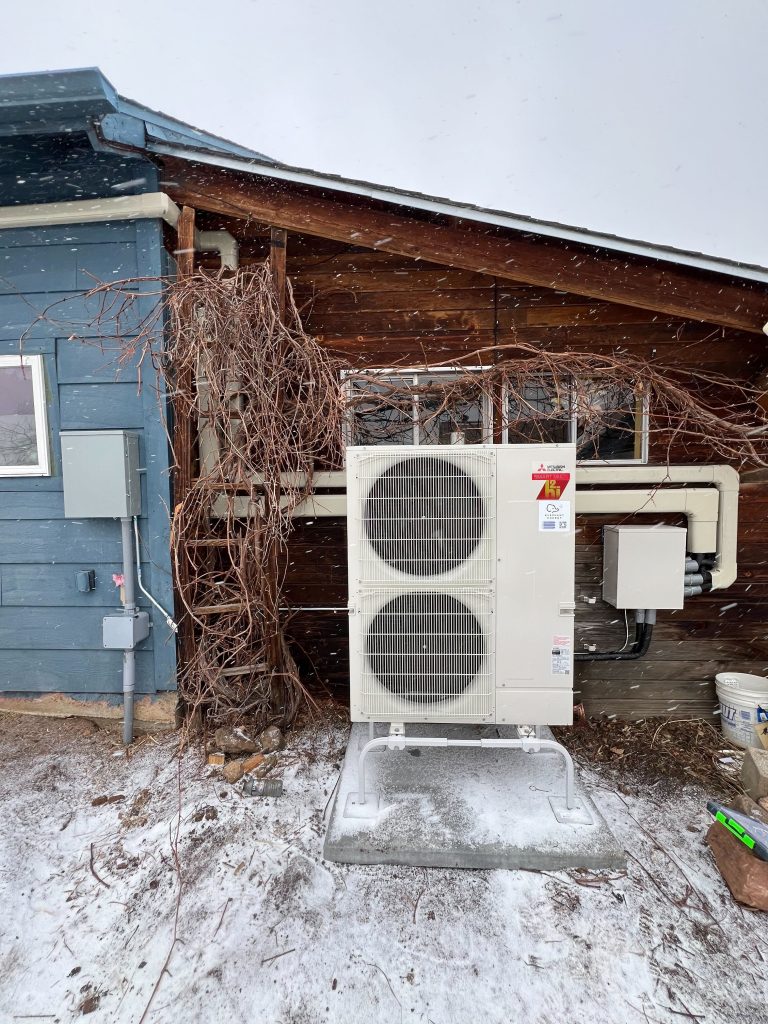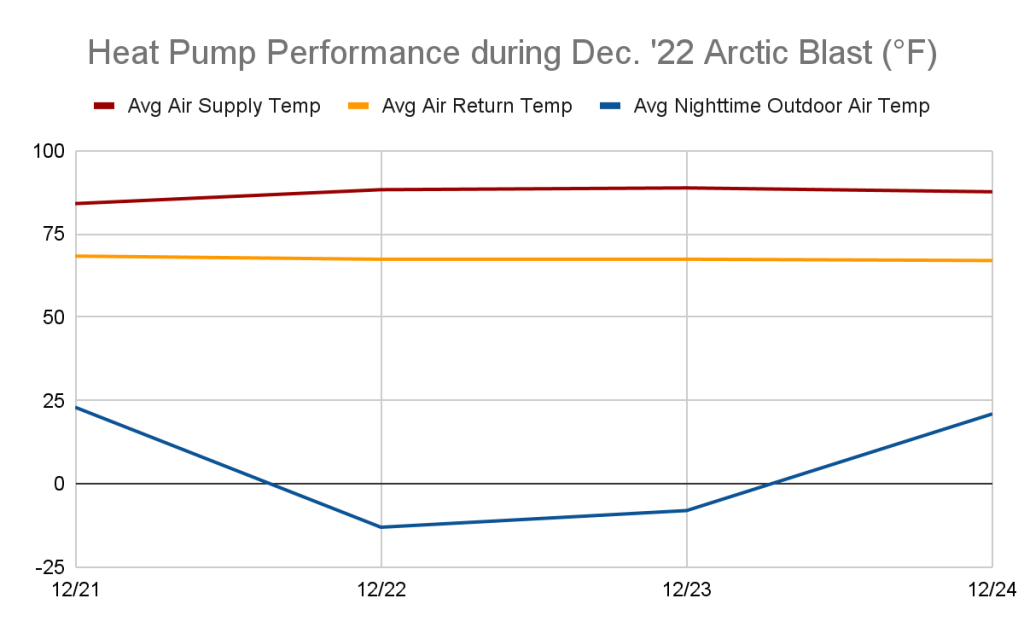“Heat pumps don’t work in the winter” – a myth
We hear it all the time: “heat pumps don’t work in the winter.” To that we say: “No, heat pumps used to not work very well in the winter. Now, heat pumps work in the arctic blast of Colorado and beyond!” Heat pump technology has come a LONG way in the past decade, rendering this belief no more than a myth.
We have installed hundreds of heat pumps in the Colorado Front Range, and they function extremely well in that climate. They’ve also proven effective in other very cold climates (for example, Alaska and Maine). However, the winter conditions in these places necessitate specially-designed cold climate heat pumps. We typically install Mitsubishi brand cold climate heat pumps, which can function at 100% of their capacity down to -5° F. No need to ask, “what temperature is too cold for heat pumps?”

We base our proprietary method for sizing heat pumps in cold climates on building science. This gives homeowners assurance that their system will provide warmth even during the coldest days. You can read more about our system sizing methodology here.
Looking for the basics on heat pumps and how they work? Check out our Ultimate Guide to Air Source, Cold Climate Heat Pumps here.
The Ultimate Test
So do heat pumps work in Colorado? Yes, our tests found them to be reliable in Arctic Blast conditions in Colorado’s Front Range. This past December, our customers’ heat pumps were put to work when the Front Range encountered an arctic blast that sent temperatures plummeting as low as -15°F. It was the ultimate test of the latest technology – and heat pumps emerged triumphant.
Even as temperatures dipped deep into the negatives, our customers’ heat pumps didn’t falter. We know this because we include a free SmartAC.com membership with every heat pump we install. This monitoring platform captures performance data for every cycle, and prevents costly breakdowns by detecting issues before they impact the homeowner. SmartAC.com also allows customers to monitor the performance of their heat pumps on their smartphones.
According to the data generated during the arctic blast, our customers’ heat pumps continued to produce supply air in the high 80’s during this period. And, the heat pumps maintained our customers’ homes at comfortable temperatures in the high 60’s. Take a look at our air return temperature data below.
What did we find out?
We saw in the data that every heat pump we’ve installed on the Front Range was able to keep up with the bitter cold temperatures.
When interpreting this data, it’s important to understand the terminology, where:
Supply Air – is the reading of the temperature of the air that heat pumps produce.
Return Air – is the reading of the temperature being maintained inside the home.


In addition to the raw numbers, we heard plenty of positive anecdotal feedback from our customers. Below are some direct quotes:
“[Our] heat pumps performed admirably during the deep freeze of last week! Huge success for the technology!
“This heat pump was pushing 95 degree air during the negative 14 degree weather last week. Super impressed!”
“Our heat pumped worked just fine the first night of sub-zero temps! …even this morning when the outdoor temperature gauge read -15, our upstairs was holding at 68!”
The data is reassuring – and illustrates that you really don’t need gas backup for your heat pump, so long as it’s rated for cold climates and sized appropriately. Hopefully, you know that you should not turn off your heat pump in extreme cold – your cold climate heat pump can handle it! Keep reading for more on heat pump sizing.
Why Getting the Properly Sized Heat Pump is Crucial
Since we operate in the Front Range, all of our home heating systems are specifically designed to ensure homes stay warm and cozy even when temperatures drop well below 0°F.
To do this, we’ve developed a proprietary sizing methodology that incorporates the industry standard Manual J approach – and adds to that real world historic data that we’ve aggregated. How does this work? Once we determine the required heating load needed to warm your home – measured in BTUs (British Thermal Unit) – we compare that to our data set of heat pump models to identify the one that will be the best fit. Finally, we compare the performance of the selected heat pump model (i.e. heat output at various temperatures) to our building science model to ensure that it can heat and cool your home all year round – including on the very coldest of days.
We also take the Total Cost of Ownership (TCO) into account in our analysis. We’ve found that, occasionally, getting a smaller system with a back up resistance heat kit yields a better, more affordable outcome since the smaller unit operates most of the year more efficiently and has a lower upfront cost due to rebates. You can read more about our philosophy on back up heating here.
Sizing Methodology
Regardless of home suitability, getting this sizing equation right is crucial for a successful and comfortable heat pump install. If the system is too big for the home, that leads to extra cost upfront. If the system is too small, it might not be able to keep up on the coldest days. Our sizing methodology is focused on finding the perfect “Goldilocks” heat pump – a system that is sized just right for both your home and your budget.
It’s important to note that the sizing methodology we’ve developed is a big departure from the way that most traditional HVAC contractors look at the world. In our experience, 99% of gas furnace installs are more like Papa Bear – way oversized for the homes they are installed in. This leads to a lot of downstream issues. Just think about blasting on / off, uneven heating and cooling, excessively high energy bills, etc.
Our Philosophy on Backup Heat Sources
Homeowners often ask if they should keep a gas furnace as a backup. We hope that the data has convinced you at this point that this is not necessary.
For particularly large or leaky homes, it may be in your best interest to install a supplemental electric resistance heat kit. It is a backup electrical heating system that will always be available to provide additional heat during the coldest weather. There are rare cases that the heat pump system is unable to provide sufficient heat on its own during extreme cold. It is when the heat kit activates and will be able to provide your home with heat at any temperature. We typically set these to kick on when the temperature drops below 15°F. Though this depends on the heating load of the home (factors include: year built, level of insulation, size, etc.) and is customizable by the homeowner.
Not all of our customers have backup heat kits, however, and many simply use a fireplace or a few space heaters in the case of a particularly frosty day. Ultimately the decision of whether or not to install a heat kit is personal. It comes down to a unique equation of cost, personal preference, and building science that looks a little different for each home and customer. Our goal is to make that equation – and the tradeoffs within it – super clear, so that you can make the best decision for your home and family.
Cooling Down
At the end of the day, it’s a personal choice. But the data speaks for itself – heat pumps do work in the winter, even in cold Colorado. And no, they won’t break the bank. In fact, they’ll most likely save you money over time, especially when compared to today’s skyrocketing natural gas prices.
So, feel confident taking the leap and being a trendsetter! Heat pump technology is tried and true, and can keep you toasty on the very coldest days – so long as your system is properly sized, and rated appropriately for the climate that you live in.
What Next?
Looking for some guidance on where to start your electrification journey? Get Your Electrification Roadmap® here.
In the Front Range and want a quote from us? Click here to get an instant estimate.
Want to learn more? Read the full white paper:
Defying the Cold: How Heat Pumps Keep Homes 68°F Inside When It’s -15°F Outside
Click Here